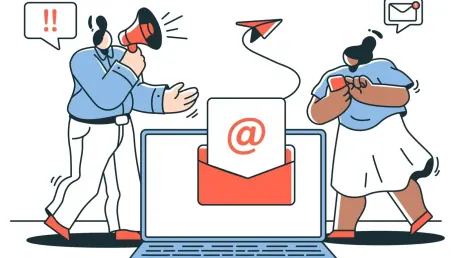Opening your email automation platform can feel overwhelming when faced with an endless array of workflows like welcome series, abandoned carts, nurturing sequences, and anniversary triggers. The paradox of choice can make it hard to focus on what really matters. However, the truth is that most email automations are just noise; they drain resources, confuse audiences, and offer limited real value. To cut through this clutter, focusing on three high-impact email automations can deliver immediate revenue gains. Let’s delve into these critical automations and how they can lift conversions and drive revenue effectively.
1. Welcome Series: Your First Impression Matters Most
Your welcome series is the cornerstone of your customer relationship, setting the stage for future interactions and potential sales. Welcome emails are known to generate 320% more revenue per email than promotional ones. With the optimal strategy, your welcome emails can form a strong first impression, cultivate ongoing customer engagement, and foster loyalty, ultimately resulting in sustained revenue growth.
This automation kicks off right after a user submits a sign-up form or engages meaningfully with your brand. Effectively structuring your welcome series is key to maximizing its impact:
Email 1: Immediate, engaging, value-focused intro message.
Send right after sign-up. This email should emphasize the main benefit of subscribing to your service or product, creating anticipation and excitement.
Include a persuasive call-to-action (CTA) for immediate engagement. Whether it’s encouraging users to explore your website, download an app, or make a first purchase, the CTA should be clear and compelling.
Email 2: Value-driven content showcasing product benefits.
Send 24–48 hours after the initial email. Highlight specific product features or benefits in detail, using concise bullet points or engaging visuals to enhance readability.
Link directly to useful resources or product pages, making it easy for users to find more information and take the next step in their customer journey.
Email 3: Use social proof.
Send about three days after the second email. This email should leverage customer testimonials or user-generated content to build trust and credibility. Featuring real-life experiences can make your brand more relatable and trustworthy.
Conclude with a strong CTA encouraging purchase or deeper interaction. Whether it’s promoting a special discount or inviting users to join a community, the CTA should drive meaningful engagement.
Recommended content for a welcome series includes product introductions that clearly explain key features, educational resources like quick-start guides or how-to videos, and invitations to join your community or read customer success stories. For example, a SaaS company could include a short tutorial video in the welcome series and a direct invitation to join their active user community, immediately driving adoption and fostering community engagement.
2. Abandoned Cart Emails: Recovering Immediate Revenue
Abandoned carts are more than just missed sales opportunities—they’re your chance to win customers back. Abandoned cart emails boast an impressive 41% open rate and a click-through rate significantly higher than average. According to Klaviyo, with effective messaging, businesses could recover 5–10% of lost sales, making abandoned cart emails one of the most potent tools for boosting revenue.
This automation is triggered immediately when users leave items in their carts without completing the checkout process.
Best practices for successful abandoned cart emails include:
- Send emails quickly (within 1 hour). Immediate follow-up captures customers while their interest and intent remain high. For instance, a subject line like “You left something behind! Return now and complete your order” can prompt quick action.
- Communicate urgency or incentives. Offer specific, tangible benefits like discounts or free shipping. Highlight scarcity (e.g., “Only two left in stock!”) to encourage swift action. An example could be “Get 10% off if you complete your purchase within the next hour.”
- Personalize the email to reflect the abandoned cart. Use images or details of the products left behind and suggest complementary items based on browsing history. For example, an online clothing store could show items left in the cart and offer an urgency-driven discount: “Your items expire soon — complete your checkout now and enjoy 15% off!”
Recommended content for abandoned cart emails should include specific product reminders with visuals, urgency-driven statements highlighting limited availability, and time-sensitive promotional offers.
3. Re-engagement Campaign: Winning Back Dormant Customers
Re-engagement campaigns are vital for improving profitability by reactivating dormant customers. Effective re-engagement efforts often result in meaningful revenue growth at minimal cost while simultaneously enhancing overall list quality.
This automated campaign is typically triggered for subscribers who haven’t engaged within a defined period (e.g., 60 or 90 days).
To effectively target inactive subscribers:
- Clearly segment inactive subscribers. Define inactivity as no opens or clicks during a set timeframe to ensure that your re-engagement efforts are focused and relevant.
- Personalize content based on subscriber history. Tailor emails using past purchase behavior or previous content interactions to make the content more relatable and engaging.
- Test varied strategies for re-engagement. Use discounts and special promotions for incentive-driven customers, emotional appeals to reconnect subscribers with the value of your offerings, and new product announcements to showcase recent developments.
- Regular list maintenance is crucial. Removing inactive subscribers can help maintain deliverability and improve overall metrics.
Recommended content for re-engagement campaigns includes subject lines designed to evoke curiosity or emotional connection, personalized recommendations highlighting recent products or content, and exclusive, limited-time offers to prompt immediate action. For instance, a fitness subscription service could use personalized messages like “We miss you—here’s 20% off your next month,” coupled with updates on recent app upgrades or new workout programs tailored to past user preferences.
Why Simplifying Automations Boosts Your Results
Focusing on these three core automations can clarify your strategy, reduce complexity, and enhance overall performance. Streamlining workflows allows you to deliver more meaningful content, fostering better business outcomes.
Clearer analytics result from having fewer automations, making it easier to track performance and identify successful strategies without unnecessary guesswork. Improved engagement stems from targeted, relevant emails that reduce message overload and boost customer relationships. Higher ROI is achieved by concentrating on high-impact automations, ensuring better use of time and resources to drive more revenue with less effort.
Simplifying your email strategy doesn’t mean doing less; it means focusing on what works best and delivering maximum value with every message.
Next Steps: Audit Your Email Automation Workflows
Opening your email automation platform can feel overwhelming when you’re met with an endless array of workflows such as welcome series, abandoned carts, nurturing sequences, and anniversary triggers. This paradox of choice can make it difficult to focus on what truly matters. In reality, most email automations are just noise; they can drain your resources, confuse your audience, and provide limited real value. To cut through this clutter, you should focus on three high-impact email automations that can deliver immediate revenue gains. These essential automations can greatly enhance your conversions and drive revenue effectively. Let’s delve into these critical emails and understand how they can be a game changer for your business. By narrowing your focus, you can achieve meaningful engagement with your customers and optimize your email marketing efforts, ensuring you get the best possible return on your investments. This strategic approach will make your email campaigns more efficient and impactful.









